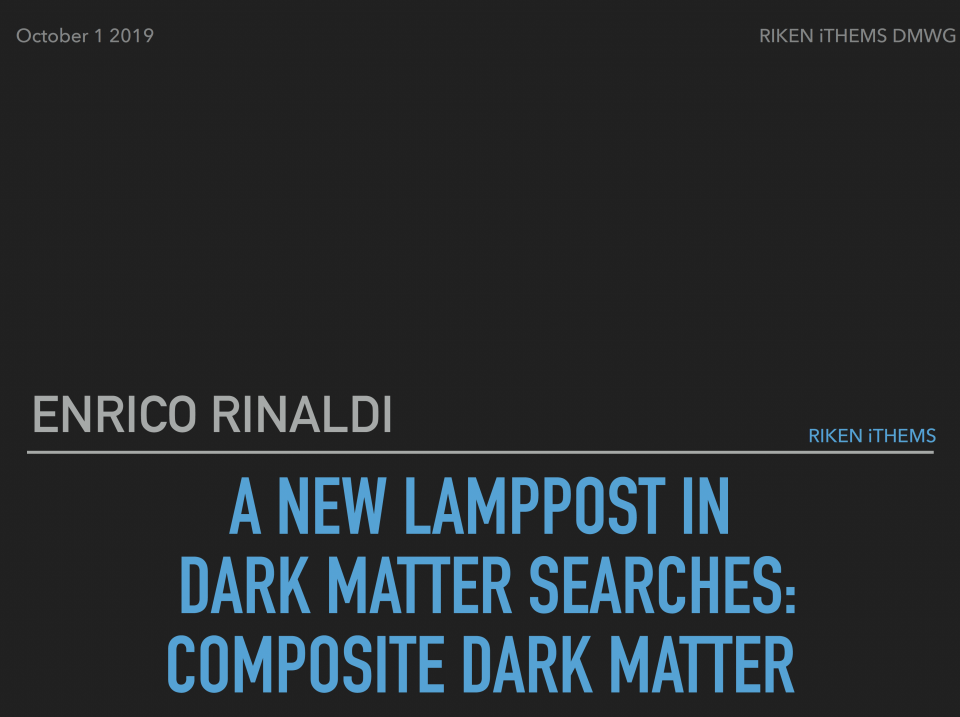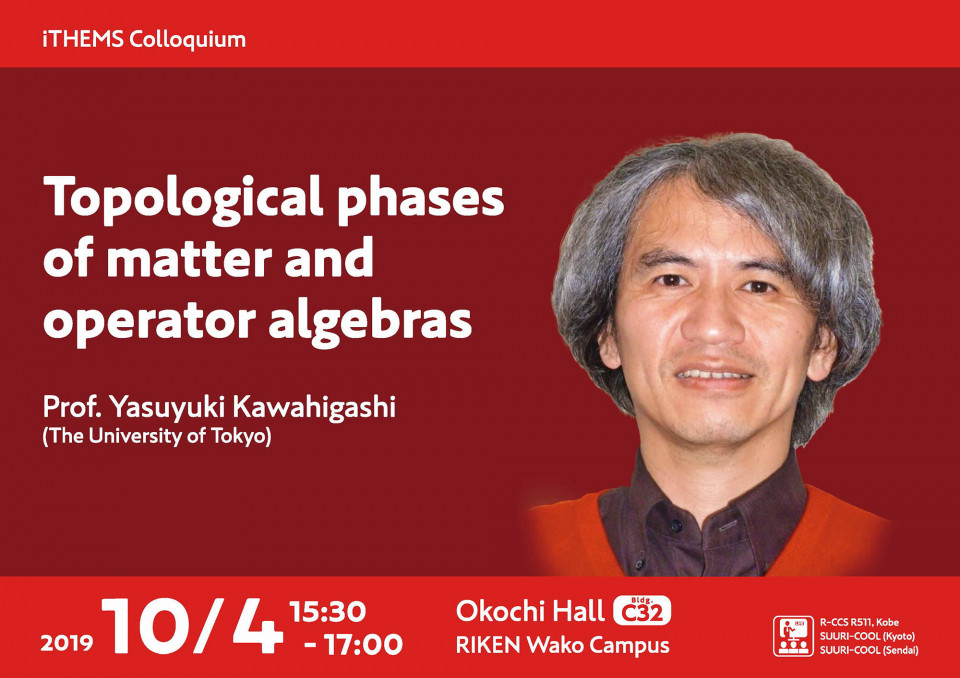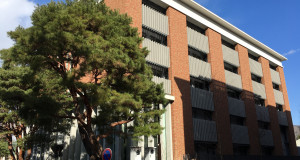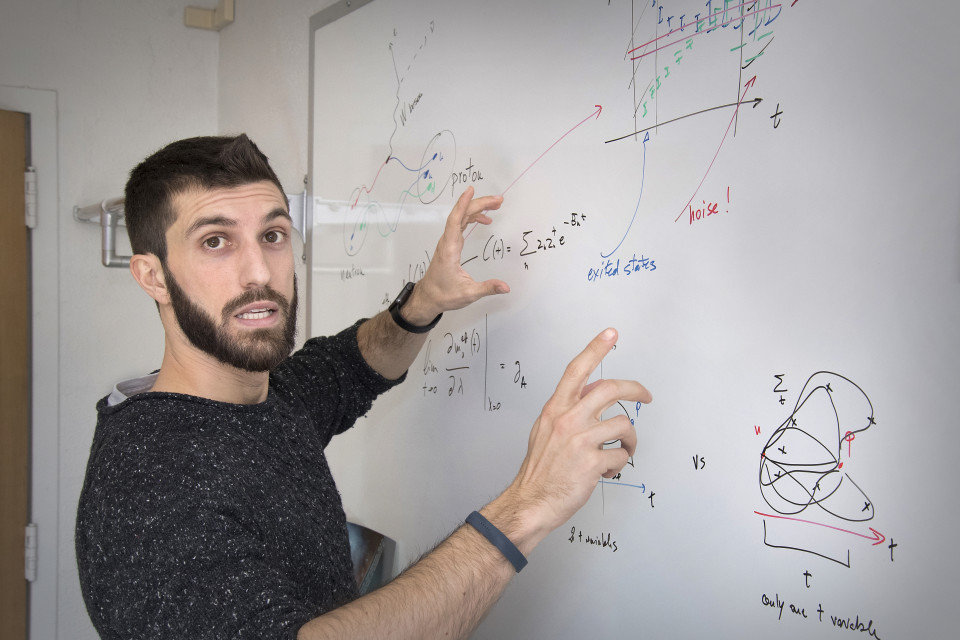Volume 72
Back to Newsletter List
Hot Topic
iTHEMS members are focused on KAGAKUDO 100 BOOKS 2019
2019-10-03
iTHEMS members are focused on KAGAKUDO 100 BOOKS 2019.
Please see the following link.
Seminar Report
iTHEMS DM working group seminar by Dr. Rinaldi
2019-10-02
iTHEMS DM working group, which aims to bridge the collider, direct, and indirect dark matter (DM) searches to obtain inclusive understandings of DM and develop new strategies for coming experiments, is launched this summer. The 1st seminar is given by Dr.Rinaldi on Oct. 1st. He talked about composite DM theory.
DM is a massive component different from ordinary matters (usually referred to as baryons) in our Universe. The nature of DM is still a big mystery and many kinds of explanations are proposed. Composite DM scenario is motivated by the origin of the mass in the standard model physics. In the standard model, the strong interaction is responsible for the proton and neutron mass hence for the mass of baryons. Considering a similar situation in the dark sector, composites of dark fermions can be DM in our Universe. The dark and the standard model sector are connected through the interaction between the constituent fermions and the standard model particles. Composite DM itself has no direct connection to our sector. This explains the non-detection of DM in the up-to-date collider, direct, and indirect experiments. Also in this scenario, the self-interaction of DM is naturally introduced. Then, it could ameliorate the small-scale problem which appears in more traditional DM scenarios. Starting from the general introduction for composite DM, his recent work based on the lattice calculations for the signatures of composite DM is also introduced. Signals from composite DM could be detected in the near future.
A series of seminars and workshops are being planned as the working group activity. Please join us!
A new lamppost in dark matter searches: Composite Dark Matter
October 1 (Tue) 10:00 - 18:00, 2019
Upcoming Events
Colloquium
iTHEMS Colloquium
Topological phases of matter and operator algebras
October 4 (Fri) 15:30 - 17:00, 2019
Yasuyuki Kawahigashi (Senior Visiting Scientist, RIKEN Interdisciplinary Theoretical and Mathematical Sciences Program (iTHEMS) / Professor, Graduate School of Mathematical Sciences, The University of Tokyo)
Topological phases of matter are hot topics in recent physics and related to a wide range of mathematical fields. I will talk about their aspects related to operator algebras. Our emphasis will be on theory of tensor categories which describe interactions of anyons. This theory plays an important role in topological quantum computations.
In theory of operator algebras, Jones initiated theory of subfactors and discovered the Jones polynomial, a new topological invariant for knots as an application. We apply this theory to mathematical studies of anyons.
Venue: Okochi Hall, 1F Laser Science Laboratory, RIKEN
Broadcast: R511, Computational Science Research Building, R-CCS, Kobe Campus, RIKEN / SUURI-COOL (Kyoto), Room 204-205, 2F Maskawa Building for Education and Research, North Campus, Kyoto University / SUURI-COOL (Sendai), Room 303, 3F AIMR Main Building, Advanced Institute for Materials Research (AIMR), Tohoku University
Event Official Language: English
Workshop
Workshop on Virtual Reality[Session 1]
October 7 (Mon) 13:00 - 16:00, 2019
Gilles Ferrand and Don Warren will run a workshop on using virtual reality (VR) for data visualization and research. Anyone from any RIKEN campus, and any field of study, is welcome. We want to build a cross-disciplinary group of people with a shared interest in VR, and to apply this tool to a broad range of data types and topics.
Please check the workshop website for up-to-date information !
Venue: Seminar Room #132, 1F Main Research Building, RIKEN
Event Official Language: English
Seminar
Finite N corrections to the superconformal index from D3-brane analysis in AdS_5/CFT_4
October 8 (Tue) 15:30 - 17:00, 2019
Reona Arai (Ph.D. Student, Tokyo Institute of Technology)
In the context of the AdS/CFT, the Type IIB superstring theory on AdS_5 \times SE_5 corresponds to an N=1 quiver gauge theory, where SE_5 is a five-dimensional Sasaki-Einstein manifold. We study this correspondence by using the superconformal index, which contains the information of the BPS spectrum in the theory. It is known that the index of the large N limit is evaluated by the Kaluza-Klein modes on SE_5 and the agreement with CFT results was confirmed in many examples. In this talk, we consider the finite N corrections to the index on the gravity side as a next step. To do this, we focus on a single D3-brane wrapped around a three-cycle on SE_5. Because there are in general several three-cycles on SE_5, we need to sum up contributions of these single D3-branes. By using the D3-brane analysis, we propose a prescription to calculate the finite N corrections to the index. We explain our prescription through some examples and see the agreement with the CFT results calculated by the localization method.
Venue: Seminar Room #160, 1F Main Research Building, RIKEN
Event Official Language: English
Workshop
KUIAS-Heidelberg-RIKEN iTHEMS joint WS "Mathematical Sciences and Medicine"
October 10 (Thu) 10:30 - 18:00, 2019
Event Official Language: Japanese
Seminar
ABBL-iTHEMS Joint Astro Seminar
Dark matter search in extended dwarf spheroidal galaxies with CTA
October 11 (Fri) 14:00 - 15:00, 2019
Nagisa Hiroshima (Postdoctoral Researcher, RIKEN Interdisciplinary Theoretical and Mathematical Sciences Program (iTHEMS))
The nature of dark matter (DM) is still a big mystery. Among the varieties of candidates, Weakly Interacting Massive Particle (WIMP) is one of the most promising ones. Gamma-ray observations of dwarf spheroidal galaxies (dSphs) by Fermi satellites put the strongest constraints at mDM<~ a few hundreds of GeV. In the near future, Cherenkov Telescope Array (CTA) starts its operations and expect to probe WIMP of mDM>~O(1)TeV.
Different from previous experiments, spatial distributions of DM in dSphs are resolved with CTA. In this talk, I explain how it affects our accessibility to DM annihilation cross-section.
Venue: Seminar Room #132, 1F Main Research Building, RIKEN
Event Official Language: English
Seminar
iTHEMS Math Seminar
Mean dimension of dynamical systems and information theory
October 21 (Mon) - 23 (Wed) 2019
Masaki Tsukamoto (Professor, Kyushu University)
Oct.21 15:30-16:30, 16:40-17:40, Okochi Hall
Oct.22 13:30-14:30, room #435-437, Main Research Building
Oct.23 13:30-14:30, room #435-437, Main Research Building
Venue: Okochi Hall, 1F Laser Science Laboratory, RIKEN / #435-437, Main Research Building, RIKEN Wako Campus
Event Official Language: Japanese
Lecture
RIKEN Open Campus in Kobe
November 9 (Sat) 10:00 - 16:30, 2019
Takumi Doi (Senior Research Scientist, RIKEN Interdisciplinary Theoretical and Mathematical Sciences Program (iTHEMS) / Senior Research Scientist, Quantum Hadron Physics Laboratory, RIKEN Nishina Center for Accelerator-Based Science (RNC))
RIKEN Open Campus in Kobe will be held on Nov.9, 2019.
Dr. Emiko Hiyama (Kyushu Univ.) and Dr. Takumi Doi (Nishina Center / iTHEMS) will give lectures on computational nuclear and particle physics at Kobe IIB building where SUURI-COOL Kobe is located. Please inform the news to anybody who are interested in visiting RIKEN Kobe.
Venue: Integrated Innovation Building (IIB), Kobe Campus, RIKEN
Event Official Language: Japanese
Person of the Week
Self-introduction: Enrico Rinaldi
2019-09-30
I am Enrico Rinaldi, a part-time researcher in iTHEMS, who was previously a SPDR fellow in RIKEN BNL and Quantum Hadron Physics Laboratory.
My expertise is Monte Carlo numerical simulations of quantum field theories, also known as Lattice Field Theory simulations, which use massively parallel supercomputers (CPU and GPU-based) around the world to solve the complex equations hiding the mysteries of particle physics.
My research is focused on understanding high energy strongly-coupled gauged theories, in particular in the context of extensions of the Standard Model (SM) of particle physics, like Dark Matter physics or theories of Composite Higgs. New discoveries are hinging on the theoreticians’ ability to make predictions that can be tested by experimentalists, and that is precisely the my goal.
I am also engaged in projects related to low-energy nuclear physics, for example calculating nucleon-nucleon interactions or nuclear form-factors directly from the theory of Quantum Chromo-Dynamics (QCD). Moreover, I have been working on matrix models to study the gauge/gravity duality conjecture with the aim of understanding the possible intriguing relation between gauge theories and quantum gravity.
I am currently researching new Machine Learning (ML) approaches to physics, mainly based on the promising rise of generative models. The aim is to improve our ability to get access to multi-dimensional parametric distributions describing physical systems with specific models.
If you would like to cancel your subscription or change your email address,
please let us know via our contact form.
Copyright © iTHEMS, RIKEN. All rights reserved.






![Workshop on Virtual Reality[Session 1] image](https://ithems.riken.jp/storage/app/uploads/public/5d8/440/1a9/thumb_1080_960_540_0_0_auto.jpg)



